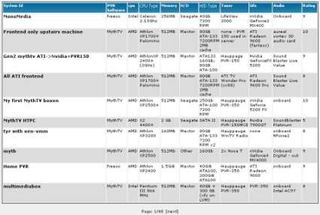Technical Discussion
Convergence technology plays a defining role in everyday digital appliances we use at home and on the move. It's nice when something just works, when an iPod synchronizes seamlessly with desktop computer data or when an incoming VoIP call registers on your television screen while you're watching a favorite program. In fact, we think you would do well to treat the MythTV suite of software applications as a harness for exercising greater control over those appliances that govern our daily activities outside the workplace.
MythTV pays court to the do-it-yourself community, a mode of operation that is decidedly inspired to make better use of everyday objects or improve upon existing designs. In fact, a certain sense of DIY gusto is the basis upon which Isaac Richards first erected the MythTV mythical convergence solution like a phoenix rising up from the ashes of previous design failures, from crippling limitations to function and utterly useless forms. Through the combined efforts of many DIY developers, MythTV has evolved into a formidable open source solution. MythTV not only matches any commercially available solutions in form and function, it surpasses many commercial designs in the number and flexibility of options it offers its users.
In and of itself, MythTV represents a framework for building an ultimate home theater system that combines radio, telephony, television and removable/recordable storage media in various useful ways. That said, MythTV is purely software, and thus lacks the hardware needed to exercise its capabilities. In other words, MythTV is not something you purchase off the shelf as a finished product like a TiVo unit - but by the same token, that is just another facet of MythTV's unmatched might in the arena of personal digital recording appliances.
As with a Media Center PC you might build yourself, you must supply your own components for a MythTV system, and therefore must forge your own experience based on the budget and usage constraints that factor into your build. Since you won't pay an annual subscription fee for user services related to MythTV operation (as you would with a TiVo) or upfront licensing costs (as with Windows MCE), total cost of MythTV ownership is limited to whatever hardware is already available for the job and that which remains to be purchased - all involving one-time fees. Related savings can be rolled into expanding your underlying hardware infrastructure to provide better storage space - how about a fast RAID-1 implementation across four serial ATA drives? Can TiVo do that easily? Or perhaps more and better tuner cards, wireless support, increased memory capacity or even a CPU upgrade. All of this is possible without voiding warranties or nullifying end-user licenses.
The following screenshot shows the searchable PVR MythTV hardware database listing provided here.

That said, what goes into a MythTV box (and subsequently, what comes out of it) is based entirely on personal choice. You control what does or doesn't qualify for the final build, you tailor the hardware and software components to your liking and you retain ultimate control over its appearance, operation and performance. Granted, this kind of total freedom can intimidate and exhaust the faint-hearted purely by the sheer number of hardware options you might consider. But that is what truly makes MythTV an extension of personal expression. Not only does MythTV align well with modern technology, in many instances it plays well with such technology, too.
Stay on the Cutting Edge
Join the experts who read Tom's Hardware for the inside track on enthusiast PC tech news — and have for over 25 years. We'll send breaking news and in-depth reviews of CPUs, GPUs, AI, maker hardware and more straight to your inbox.
Ed Tittel is a long-time IT writer, researcher and consultant, and occasional contributor to Tom’s Hardware. A Windows Insider MVP since 2018, he likes to cover OS-related driver, troubleshooting, and security topics.
Most Popular


